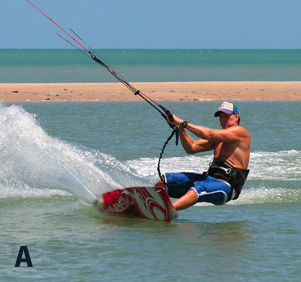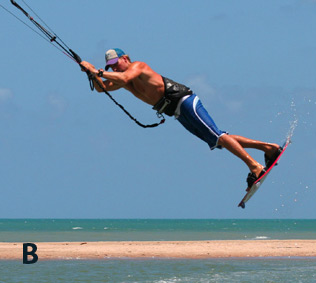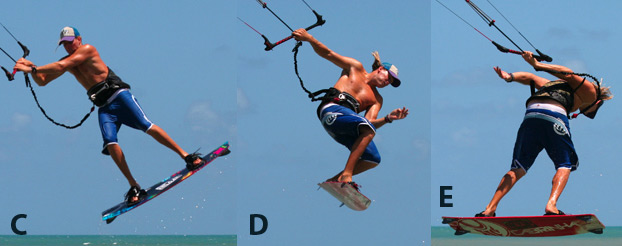Shifty 3
Shifty 3
Back then we covered the shifty to wrap. If you’ve got that down you will have no uncertainties, thoughts about or even tried its advance version, the shifty 3 – an energetic technique which positively looks chipper and even more strikingly, and thus the key to several moves. Master this technique and later on you’ll be adding up new moves to your routine faster than you could imagine.
Whilst mastering this technique, there are some other things that you’ll have to insert to get the popular air pass in. So let’s not waste time and get this job done.
Elevation and Timing
Stating the obvious is as good as a place to begin. Instead of giving yourself the necessary elevation and timing to do it, you could do a lot worse if you just settle for an average pass. Perhaps you’ve already presumed that the launch should be quite aggressive.
Pic A.
 The surfer is about to pop in an instant. In our Shifty, we consider popping a little serious to make sure we could turn to shifty without the board going into a raley. Now being aware of it, we should be able to edge hard and still get the board behind us. In this picture, the surfer is carving hard across the wind with his weight low and his board upwind. As a matter of fact, the take off of a raley is somehow similar to this. The only thing to prevent this into turning into raley is the head. Observe that his shoulders are not turning up into the wind, only his hips and the board because his head is positioned well looking forward and downwind.
The surfer is about to pop in an instant. In our Shifty, we consider popping a little serious to make sure we could turn to shifty without the board going into a raley. Now being aware of it, we should be able to edge hard and still get the board behind us. In this picture, the surfer is carving hard across the wind with his weight low and his board upwind. As a matter of fact, the take off of a raley is somehow similar to this. The only thing to prevent this into turning into raley is the head. Observe that his shoulders are not turning up into the wind, only his hips and the board because his head is positioned well looking forward and downwind.
You would want this edge and carve for two good reasons. Clearly you need to get a fierce pop for the elevation, but even more importantly is that you need the pop to be able to make the pass in the air. By edging like this, you clutch the kite back while it drops back in the window and you can blast off against it. The kite hurls forward once you pop, and as you go faster after it, the lines slightly relaxes, giving you the chance for a timely pass.
Pic B. – Patience
 This is the in-flight amusing phase of this technique. The surfer has done a nice slow shifty. The focus here is to prepare you for the pass. When you feel the kite is puling, you must go with it. The surfer has his arms flexed maintaining the bar below the shoulders to gain balance. He’s in a superior position, all set to pull hard when he needs to. If you extend your arms, you’ll have further to pull which requires more power and more time.
This is the in-flight amusing phase of this technique. The surfer has done a nice slow shifty. The focus here is to prepare you for the pass. When you feel the kite is puling, you must go with it. The surfer has his arms flexed maintaining the bar below the shoulders to gain balance. He’s in a superior position, all set to pull hard when he needs to. If you extend your arms, you’ll have further to pull which requires more power and more time.
The surfer extends his rear leg behind him to keep his body up. Just like in the wrapped version, the surfer needs this leg to produce speed for the spin and to give his lower body enough forward drive for the board to land in front and not get left behind. Also you should plan to thrust the leg back immediately after launch.
Last thing to remember for this part is to make sure you have your kite set in the right position. Pulling the bar up can make the pass even more tough.
Pic C. – The Pull Down
The time has come when just as the surfer senses that he will drop. It is an indication that the tension has gone off from the lines and it is time to make the pass. Observe his arms; the surfer stretches his arms with the bar down towards his back hip, so it’s like pulling the bar in and at the same time also pushing it down. You can also see that the surfer’s rear leg is coming through to provide him the spin. His right knee is on a course towards his hands and the bar. During all of this, the surfer still has both hands on the bar. You should get the bar in and low because using your both arms is a lot easier.
Pic D. – The Spin
Before we proceed, observe the surfer’s right leg. In the previous picture it was coming through and was rather straight. Nevertheless, the surfer brings his knee up once it is underneath him. This is the time where you should let go of your front hand off the bar. In bringing the legs up, the weight of the board comes up and it will not draw you down. Immediately as the surfer let go of the bar, he turns his head and twists the bar, which allows him further turning his shoulders.
Pic E. – Don’t Give Up, Try and Try
Having twisted his wrist, the next thing he needs to do is to grab the bar with his free hand. So he has to concentrate on having his hand around the bar. At first you’ll have a hard time and is most likely the main obstacle when moving from surface passes to air passes. It’s a good idea having the bar ready but it’s no good if you untimely get the other arm around.
This is the portion where most kite surfers think, “I’ve missed it” and just let go. You have to spin around the arm with the bar, so you won’t turn fast when you release it. You will be in a position where you can get to the bar if you hold on. If you can shift the hand quickly and hold on, you will turn just in time. As a matter of fact, you know that you could turn this far because you can already wrap.
The board is now underneath the surfer and is ready for landing. As long as the knees are flexed up, the board will spin with you. It will get left behind if you keep your legs extended.
Best Tips
In this technique, you should also concentrate on the small details due to a lot of pass moves. It can help if you give the kite a sharp pull down with your front hand prior to passing. This will prevent the kite from dragging the bar up and away, and also it will encourage you to keep both hands on the bar. Aside from that we’re back to getting the elevation so you will have time to
Sequence Summary
1. Position your kite around 11 o’clock. Gather up some speed and bear away to let loose, keeping your shoulders back and your hips low.
2. Carves hard up across the wind with your weight over your rear foot and your front leg extended. Look forward and downwind.
3. Continues to look forward upon take-off.
4. Quickly turn your rear foot behind you, extending your rear leg.
5. Maintain your arms bent and your head above the bar. If the kite continuously goes high up, this would be the ideal time to hurl it down.
6. Pull and push the bar hard down towards your back hip, while pulling your back knee in towards your hands to begin the spin.
7. Let go of your front hand and bend your knees up, while moving your head and free hand around with the rotation.
8. Having your wrist twisted. Put the bar where you will be able to reach it. All your effort now is concentrated on getting your free hand around and onto the bar. Grasp on tightly with your right hand, so that you can spin your arm and reach the bar.
9. Grab the bar and let go yourself out of the arm lock, while dropping back down to the water surface.
10. Eventually, land on a flat board successfully.
Usual Problems
If you can’t reach for the bar though you are holding on, chances are, your kite is way too high. However, you will see a lot of surfers doing this technique with their kites quite high, but they’re either amateurs or wannabe’s. Just position the kite no higher than 11 o 1 on your advance, and give it that pull down before passing.
You are spinning too slowly. The key is to simply just use your legs and crunch the knees up. Synchronizing your legs with the arms and pulling with both hands will give you a nice quick spin.
You are not spinning far enough around.
If the kite is dragging you hard, it can halt your spin. There few probabilities here. First, if you set out too early the kite will still be dragging you and thus it pulls you back as you turn away from it. So give it a lot of thought and wait for a timely opportunity.
Having too much power or the kite is dragging you like a train, it may pull you hard all the way through the movement. Importantly, make sure you are trimmed correctly, or if needed to be adjusted down. The more power you have the harder you’ll need to carve and pop to make the kite more controllable.
Important Reminders
1. Burst with speed and pop hard
2. Kick leg, pull arms in and wait
3. Both hands down to back hip
4. Back knee up to hands
5. Hold on and quick free hand
Here are some dudes that know how to perform this trick!

